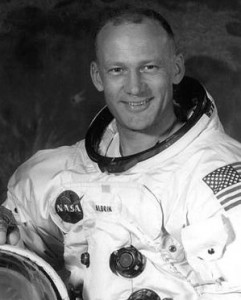Colonel Buzz Aldrin, USAF (Ret)
 On December 26, 1951, then-Lieutenant Buzz Aldrin arrived in Seoul, Korea. A recent graduate of West Point, Aldrin had become a fighter pilot in the Air Force. Aldrin was assigned to the 51st Fighter Wing, and flew 66 missions in the F-86 Sabre, shooting down two MIG-15s and earning the Distinguished Flying Cross.
On December 26, 1951, then-Lieutenant Buzz Aldrin arrived in Seoul, Korea. A recent graduate of West Point, Aldrin had become a fighter pilot in the Air Force. Aldrin was assigned to the 51st Fighter Wing, and flew 66 missions in the F-86 Sabre, shooting down two MIG-15s and earning the Distinguished Flying Cross.
Flying with several comrades in the16th Squadron, five miles south of the Yalu River on May 14, 1952, Aldrin spotted two planes below. With his wingman at his side, Aldrin dove at the second plane and opened fire. As bullets slammed into the enemy MIG and its engine caught fire, the pilot ejected and began drifting down to earth. While Aldrin’s first kill lacked the thrill of a dogfight or intensive maneuvers, it marked a historical moment. The camera attached to his gun trigger snapped photos of the ejection sequence, creating the first photos of the war to show a pilot bailing out of his plane. The photos would appear the next week in LIFE magazine.
If his first kill lacked drama, Aldrin’s second would make up for it, and then some. On June 7, he was flying in a formation directly behind another formation. When the first formation’s wingman had engine trouble and had to return to base, Aldrin radioed ahead and offered to join them. He soon found that the first formation was flying the F-86F, while he was flying the slower F-86E, which made it difficult for him to keep pace.
The mission that day was to bomb power plants along the south edge of the dam at Suey Ho, a critical power installation. In order to provide protection to the fighter bombers, the fighters had been given permission to fly briefly across the Yalu into China, a rare occurrence, as pilots were usually strictly forbidden to cross the border so as to not provoke the Chinese to escalate their involvement in the war.
While Aldrin sped to catch up, he realized something was off as the planes went right past the dam, and continued north. In reality, they were flying on an unauthorized mission to attack an enemy airfield some 50 miles into Manchuria.
Caught some distance behind the rest of the formation as it moved in for the attack, Aldrin encountered a Russian MIG-15. The planes maneuvered in a scissors pattern, each jockeying to gain an advantage over the other. Eventually, Aldrin, whose F-86 had superior maneuverability over the MIG, worked his way behind the enemy plane, and fired. The MIG began to smoke and descended, its pilot ejecting to safety. Low on fuel and lucky to not have any other MIGs on his tail, Aldrin headed back to base.
After Korea, Aldrin served in Germany, before earning his Doctorate of Science in Astronautics at MIT, writing his thesis on Manned Orbital Rendezvous. Selected by NASA in 1963 into the third group of astronauts, Aldrin pioneered a number of training techniques, including substituting underwater training for zero-gravity flights. In 1966, on the Gemini 12 orbital mission, he performed the world’s first successful spacewalk.
Then, on July 16, 1969, Aldrin embarked on the most important, and legendary, mission of his career…
At 9:32 AM, Eastern Daylight Time, a Saturn Five rocket blasted off from Kennedy Space Center in Florida. On board were astronauts Neil Armstrong and Michael Collins, along with Buzz Aldrin. Their destination: the moon.
Four days later, the lunar module, dubbed “Eagleâ€, separated from the command module high above the surface of the moon. The Eagle began its descent, landing in the Sea of Tranquility at 20:17 Coordinated Universal Time on July 20, 1969.
A few hours after landing, Aldrin said over the broadcast, “This is the LM pilot. I’d like to take this opportunity to ask every person listening in, whoever and wherever they may be, to pause for a moment and contemplate the events of the past few hours and to give thanks in his or her own way.â€
More than 600 million people – the largest television audience in history – would tune in to witness the historic event, as Armstrong and Aldrin became the first men to walk on the moon.
Since returning from the moon, Aldrin has remained active in space exploration, devising a plan for missions to Mars, a modular space station, Starbooster reusable rockets, and multi-crew modules for space flights.
From fighter pilot in Korea to pilot of the Lunar Module that made the first moon landing forty years ago, to his work since, Buzz Aldrin has continued to serve his country with honor. The training and experience forged by his military career begun over the skies of Korea took literally took him farther than any man had gone before. It is for this outstanding service to country, and to mankind, that the American Veterans Center presents Colonel Buzz Aldrin the 2009 Raymond G. Davis Award.










